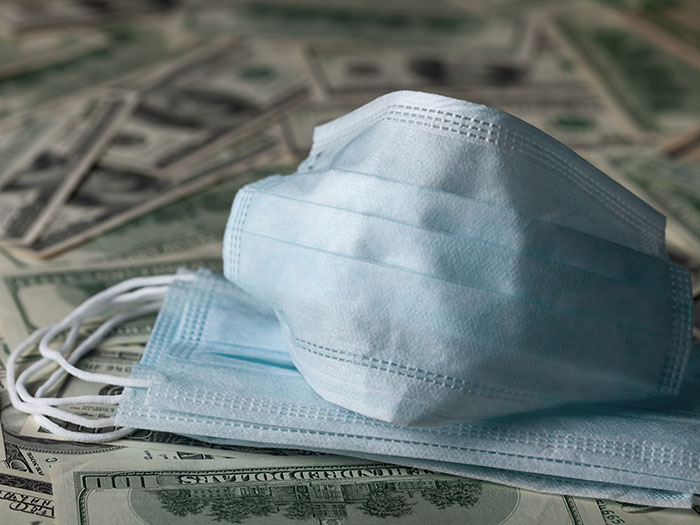Longer Claims, Falling Premiums: NCCI Details How COVID-19 Could Affect Workers’ Comp

It seems like everywhere you look, the economic effects of COVID-19 are on display.
The stock market has been going wild. Businesses are shuttered and some have closed permanently, causing the U.S. to lose 26.5 million jobs. Layoffs and furloughs are also contributing to this increasing rate of unemployment.
Hotels and restaurants are struggling. Retail giants have had to declare bankruptcy. Without a cure, the virus will continue to spread and predictions of a second wave will likely lead to even more economic loss.
While the economic effects of COVID-19 are easy to spot in industries such as hospitality and retail, in workers’ compensation, it may be more difficult to tell how the novel coronavirus is affecting payers’ wallets.
A recent report from NCCI took a look at the economic impact of the virus on the workers’ comp industry.
The Report at a Glance
NCCI broke down several statistics about the state of U.S. employment and what that means for the economy as a whole.
The Numbers: The report laid out several key unemployment statistics and compared them to past economic downturns in the U.S.
In the four weeks preceding April 11, 22 million new unemployment claims were filed. Comparatively, 52 million unemployment claims were filed during 2008 and 2009, the first two years of the Great Recession. The U.S. unemployment rate has jumped from 3.5% in February to 4.4% in March.
The Takeaways: Based on these statistics and others found in the report, NCCI suspects that temporary business closures are less likely to have the same economic impact as the Great Recession, which was fueled by sustained job loss. But they could still result in workers’ compensation premiums dropping.
“To be sure, layoffs happened at an unprecedented scale during March and may accelerate in April. But a recession’s economic impact depends on duration as well as intensity,” NCCI reported.
“During the Great Recession, unemployment stayed between 8% and 10% for more than three years, from February 2009 through August 2012, with a slow recovery thereafter.”
Despite the fact that COVID-19 may not cause the same kind of long-term recession that the U.S. saw in 2008, workers’ compensation may still see premium decreases.
NCCI predicts that premiums will decrease by more than the unemployment rate, but for slightly different reasons than when they fell during the Great Recession.
During the 2008 recession, NCCI reports, premiums decreased due to unemployment in contracting and manufacturing, two industries with high injury frequency and severity.
Layoffs at small firms, which are more likely to elect first-dollar workers compensation coverage, also contributed to the drop in premiums during the Great Recession. These have also been common during COVID-19 and are likely to contribute to a premium decrease for policy year 2020.
What Else Is in Store for Workers’ Comp?
Although it may seem logical that an uptick in claims could be caused by employees claiming they contracted COVID-19 on the job, most of the effects that workers’ compensation payers are seeing are due to active claims or fears over unemployment.
In the case of active claims, many injured workers are experiencing delayed recovery due to the pandemic. Hospitals and clinics have halted non-essential surgeries and procedures to free up resources, conserve supplies for doctors treating COVID-19 patients and to prevent the spread of the virus.
For some injured workers, this may mean that their treatment could be deferred until after hospitals are no longer stressed by the novel coronavirus. Other injured workers may not be able to access treatment due to the fact that physical therapy facilities and other out-patient treatment may be closed due to a lack of patients, according to the NCCI report.
“Doctor’s offices and physical therapy clinics need a minimum number of patient visits per day to break even and most depend on payers other than workers compensation,” the report said. “As other patients cancel non-essential appointments, providers are forced to reduce staff or close temporarily.”
On the payer side, all of this translates to delays in return-to-work, longer claim durations and more money spent paying lost wages for injured workers. Telehealth may be able to mitigate some of these claims, but the long-term effects of those programs remain to be seen.
Fears over unemployment, on the other hand, can cause workers to file claims over smaller and non-acute workplace injuries.
“During the pandemic, workers who expect their employers to stay in business may choose to defer reporting of workplace injuries that are non-acute and for which treatment can be postponed, for example, cumulative strains or degenerative conditions,” NCCI notes.
While workers’ experiencing layoffs may lead to an uptick in smaller claims, recessions can result in a decrease in claims over $1 million, other NCCI research has found.
With an on-going pandemic it can be difficult to gauge just how much of an effect COVID-19 related unemployment will have on the workers’ compensation industry. While the 2008 recession can be used as a guide to predict economic turmoil, much of the long-term impacts remain to be seen. &










